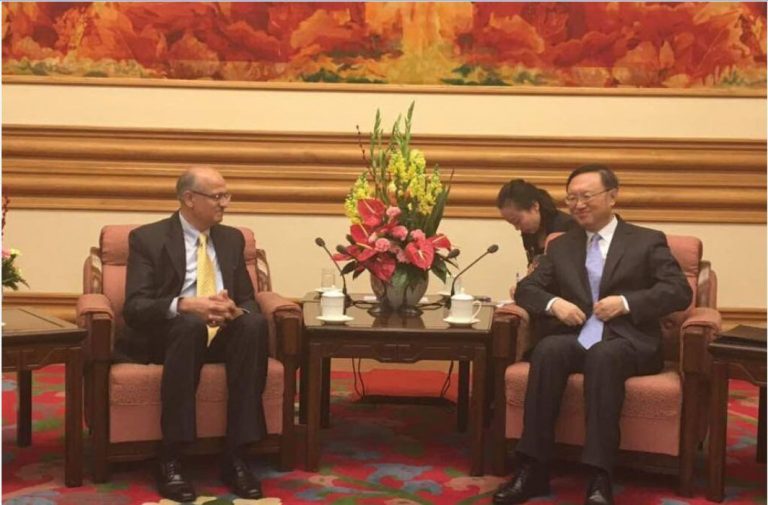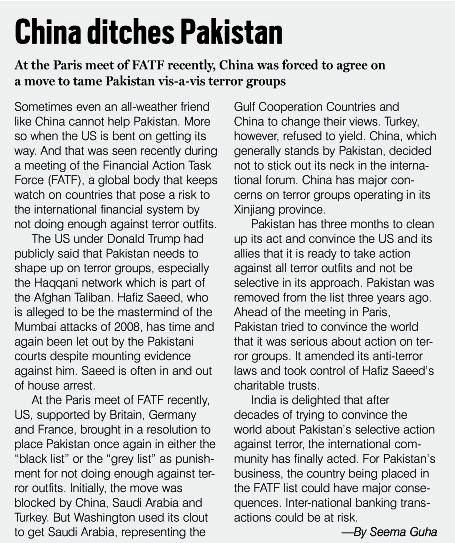
Above: Foreign Secretary Vijay Gokhale with Chinese minister Wang Yi/Photo Courtesy: Twitter
Though the foreign secretary’s visit to Beijing was meant to get ties back on the rails, Doklam-type incidents are likely to take place again as China pursues territorial claims
~By Seema Guha
India’s new foreign secretary Vijay Gokhale’s weekend visit to China recently is an obvious attempt by Delhi and Beijing to get relations back on track after last year’s Doklam stand-off. Though the two sides reached an agreement then, relations remained testy. Prime Minister Narendra Modi travelled to China for a multilateral meet afterwards.
Now both the Asian giants are actually hoping to repair the damage and get bilateral ties moving again. Modi is scheduled to be in China in June for the Shanghai Cooperation Organisation summit. Now is as good a time as any to start work on getting the optics right for future high-level visits.
ASIAN RIVALRY
India and China share a complex relationship and are natural rivals in Asia. Though China is far ahead in both economic and military might, and is angling to take on the US, it will first have to stamp its dominance in Asia. India, an equally large and populous nation, is an obvious challenger, though it is neither as rich or as powerful as China at the moment. But there is potential. The rivalry between these two Asian powers will remain, yet as mature nations, both countries want to ensure a working relationship and not allow tensions to dominate the bilateral narrative.
Does Gokhale’s visit mean that there will not be a repeat of Doklam? “No,” said Ashok Kantha, a former ambassador to China. “I will not be surprised if more such incidents happen, at different points on the border, as China is pursuing its contested territorial claims all across. We see its remarkable determination to mark its claims, both in South China Sea and Indo-China border.”
A powerful China is now much more aggressive in staking its claims in the Indo-Pacific region. This had led to a Pivot to Asia policy by the Obama government earlier. Trump is building on this. ASEAN nations, many of whom also have claims to South China Sea’s territorial waters as well as the islands and reefs dotted across the ocean, are keen that the US continue to remain in Asia. Like the US, ASEAN states want India to be more active in the region to offset China’s overwhelming naval clout. Americans have long suggested joint patrols by the US and Indian navies in the Indo-Pacific region. So far, the Modi government has not said yes. However, joint exercises with Singapore and other ASEAN nations are on. Navies of India, the US and Japan regularly conduct annual Malabar exercises in the Bay of Bengal, Indian Ocean and the east Pacific. This, despite earlier Chinese protests.
INDO-US TIES
India’s close ties with the US are certainly of concern to China. The US, since the time George W Bush signed the civil nuclear deal with India, has made no bones about wanting to facilitate India’s rise to counter China’s growing military and political might in Asia. President Trump is expanding on Bush’s initiative. China keeps a close eye on Indo-US developments and is well aware why America is keen on helping India’s rise.
So intrusions will continue, according to Kantha who now heads the Institute of Chinese Studies in Delhi. Doklam also involves Bhutan and is part of the contested border between China and its tiny neighbour. There are indications that Bhutan and China will have another round of border talks in March. The exact dates are not known.
Bhutan is India’s closest ally in the region. The Indian army confronted the PLA in Doklam as part of its mandate to look after Thimpu’s security. The Chinese have removed their road building material from Doklam and Indian soldiers went back to their former position when the stand-off ended. India will be in the loop on the border talks between China and Bhutan. National Security Advisor Ajit Doval and foreign secretary Gokhale were in Bhutan ahead of the announcement.
China and Bhutan have held 24 rounds of border talks so far. In 1996, after the 10th round, an agreement was almost reached but fizzled out. Bhutan is one of the few countries with which China has not fixed its land border problem; India, of course, is the other.
PAKISTAN LINKS
The Indian establishment has never trusted China since its humiliating defeat in the 1962 border conflict. Beijing’s close ties with Islamabad is a given since Independenence. China-Pakistan political and defence relations are now bolstered by strong economic links. China has invested over $60 billion in the mineral-rich restive Balochistan province of Pakistan where the Gwadar Port, managed and built by the Chinese, is located. Pakistan is now at the centre of Chinese President Xi Jinping’s One Belt One Road initiative.
While on India’s western border, Pakistan-China strategic ties are being strengthened, Afghanistan, on Pakistan’s west, is close to India. This annoys the Pakistani military no end as it had built up the Taliban to gain strategic depth in Afghanistan.
What is of concern now is that China’s footprints are spreading in India’s neighbourhood. In Nepal, a pro-China prime minister, KP Oli, has just taken office. He played the China card during India’s unofficial blockade of Nepal in 2015, and had signed a trade and transit agreement with China. Oli has clearly said that while India was an important neighbour, Nepal cannot forget China. Ties with China would give Nepal a choice to navigate better in the world of trade and diplomacy. Nepal suffered miserably during the blockade and Oli became popular for standing up to India.
Meanwhile, in the Maldives, where Abdulla Yameen continues to get China’s backing, or even in Sri Lanka, Myanmar and Bangladesh, China’s chequebook diplomacy continues. Analysts in India continue to talk of China’s String of Pearls around India with Gwadar, Colombo and Humbantota, as well as attempts to build a sea port in Myanmar and evenin Bangladesh.
Gokhale’s visit to Beijing will smooth the way for high-level visits on both sides, but is unlikely to change the basic mistrust in ties. Unless the border question is settled, intrusions will continue. Despite earlier talks of the Asian century and India and China growing together peacefully, the reality is very different.


